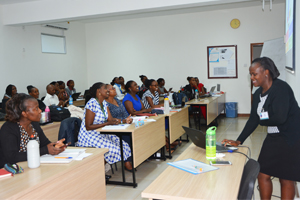Game-based learning: using technology to enhance active learning in a health assessment course
This story is written by Ms. Beth Waweru, Instructor, School of Nursing and Midwifery, Kenya.
Introduction
My teaching philosophy revolves around active learning and understanding of concepts by the students and that learning has to be interesting. My approach of teaching hence reflects this philosophy and that is why I chose Kahoot as part of my instructional methods in the Health Assessment Course.
Concept of Digital Game-Based Learning (DGBL) as used in Health Assessment Course
The theoretical foundation of games as a teaching and learning strategy was first described by Kolb in his experiential learning model. Game-based learning is considered to be risk-free and it encourages exploration and trial-and-error actions with instant feedback and hence stimulates curiosity and learning(Hussein, 2015). Digital game-based connects educational content with a computer or video games and can be used in almost all subjects and skill levels. With the advancement in technology, students need to be prepared to participate in the globalized technological society of the 21st Century in the course of their learning. Learning also needs to be interactive and interesting with instant feedback.
What is Kahoot?
“Kahoot! is a free online classroom response system designed to allow instructors to quickly and easily create question-based learning games that can be used to assess student learning, review concepts, teach new material, and/or facilitate classroom discussions”(Graham, 2015). The Kahoot platform is a simple and intuitive game development tool that allows instructors to skip the technical hurdle they might otherwise encounter in developing a digital game and focus instead on instructional outcomes (Graham, 2015).
My Experience
I mainly use Kahoot to evaluate whether students have done their pre-lesson reading and how well they have understood the material. It assists me to utilize the limited lesson time to clarify concepts that were not well understood and build on what is already known. Occasionally, I use Kahoot, to evaluate post-lesson.
Initially, some students resisted. In my first lesson, some students were reluctant to connect to Kahoot and opted to work with their desk mates. So I had just a few participants but I rewarded the winners. In subsequent lessons, I had more participants all hoping to be cheered up as winners and as we progressed it became more interesting.
At the end of the course, I did a simple evaluation of Kahoot as a teaching strategy. I used a Likert Scale type of questions with 1-4 points. There were also two open-ended questions of what they liked most and what they did not like about Kahoot. Most of the responses on the Likert scale questions ranged between 1-2. Twenty-four out of twenty-six students participated in the evaluation. Most students rated the use of Kahoot high. Below are some of the students’ responses on what the students liked most and what they did not like:
The use of Kahoot: “ made lessons interactive” “Very interesting and fun” “Encouraged me to read prior to lessons” “Enabled me to improve thinking ability” “Fast way of learning concepts” “Nice way of keeping learners awake”.
Some students felt that the time for answering the questions was not enough as stated in this comment: “there was no time to think”. Use of technology was also a challenge.

Conclusion
DGBL engages students in their learning and makes learning interesting. The instructor is able to assess whether or not learning has taken place and can give prompt feedback to students.
References
Graham, K. (2015). TechMatters: Getting into Kahoot!(s): Exploring a game-based learning system to enhance student learning. LOEX Quarterly, 42(3), 4.


